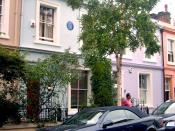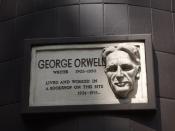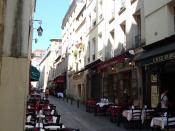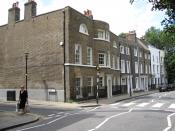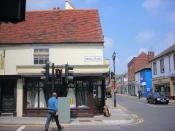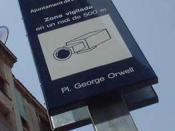A Critical Appreciation of "Down and Out in Paris and London"� by George Orwell "Down and out in London and Paris"� is more than a work of fiction. It is semi-fictional in that it was the culmination of a number of years between 1928-31 spent in the slums of Paris and wandering around London as a tramp. This soon became a quest, by Orwell, to uncover the lives of the poor and to reveal the variety of characters and life to be found in the slums. What is clear is that Orwell's book is more than a series of anecdotes. If anything, these anecdotes are case studies used to put across a social message. Orwell uses his representation of characters, settings and themes to break down socially imposed barriers between rich and poor.
The setting is all-important for getting Orwell's message of reform across. From the opening Orwell presents us with a Parisian scene which seems almost Dickensian (another writer who challenged established society).
The passage "It was a narrow street "" a ravine of tall, leprous houses, lurching towards one another in queer altitudes"� gives the buildings a sinister personification. This feeling of isolation is seen in Great Expectations when Pip is confronted with London: "The distorted adjoining houses looking as if they had twisted themselves down to peep down at me."� (p. 151) Orwell's use of settings is vital. Firstly it helps give Orwell's story authenticity but it also seeks to highlight the grim reality of poverty. Orwell does this by stimulating all of the reader's senses to help them envisage the scene, and this is done to great effect. Every detail of discomfort in the Hotel X is imparted to us: The "stifling"� cellar, the "deafening"æclanging of pots and pans"�, the 110 degrees Fahrenheit heat. In fact, in light of the moralising middle class, the kitchen is given almost a hellish quality. "In the middle were furnaces, where twelve cooks skipped to and fro, their faces dripping with sweat"æRound that were counters where a mob of waiters and plongeurs clamoured with trays. Scullions, naked to the waist, were stoking the fires and scouring huge copper saucepans with sand."� (p. 51) This almost grotesque display can to be found later in the book, during bathing at Romton spike. "Fifty dirty, stark-naked men elbowing each other in a room twenty feet square, with only two bath tubs and two slimy roller between them all."� (p. 129) Despite the different atmospheres of the scene there are common feelings of demoralisation and dehumanisation. But because of this there is a great sense of injustice, an injustice that Orwell wants to reveal. A prime example of this injustice can be seen through inequality. This occurs at Lower Binfield when the "Tramp Major"� discovers that Orwell is a gentleman. "Thereafter he treated me with unfair favouritism, and even with a kind of deference"� (p. 173), the Tramp Major even seemed to believe that because Orwell was a gentleman he did not deserve such a life where as the others did! But the Tramp Major is very much a temporary character, and one there to prove a point. Many other characters also seem to be exaggerated and adapted simply to prove a point. For example Madame Monce seems to be a caricature of an inconsiderate landlady who, because she is not paid much, is not troubled by the conditions in her filthy, bug infested hotel. Other characters, such as the elderly tramp who is happy to live on ten shillings a week, are there to show that just because people are poor it does not make them any less decent or honest than others. Ironically it is because Paddy is so starved that he does not have the courage to steal. Virtuosity "bred of hunger."� (p. 134) But Orwell does not just use characters as tools in a moral crusade. "I am trying to describe the people, not for the mere curiosity, but because they are part of the story."� (p. 9) Many of Orwell's characters are extremely strong and complex, this because Orwell skilfully selects certain mannerisms, expressions and the subjects of their conversation. They have stories to tell which makes them more than two-dimensional and means the reader can sympathise with them as individuals. The jovial Charlie is given a more sinister side when he tells the tale of how he beat up a prostitute and, believing it to be love. Boris is given a very human side as he fluctuates between optimism to despair depending on the time of his last meal.
The narration in the book is vitally from a first person perspective, and this is extremely important. Firstly, the text is semi-autobiographical. Orwell's viewpoint and style means that he can talk about the poor to people of his own class background, and take opportunities to explain the details of a life of poverty (the slang for example.) Secondly, while Orwell can help us to believe that his character has really been through this poverty, it also gives Orwell the opportunity to blatantly voice an opinion or to come to a conclusion, conclusions with social implications. "People who have fallen in to solitary, half- mad grooves of life and given up trying to be normal or decent. Poverty frees them from ordinary standards of behaviour, just as money frees people from work."� (p. 7) But his work has also political value as he takes opportunities to make recommendations. This is truly a report on poverty from one who has had first hand experience.
BIBLIOGRAPHY George Orwell, Down and Out in Paris and London (Penguin 1981) Charles Dickens, Great Expectations (Penguin 1994)
